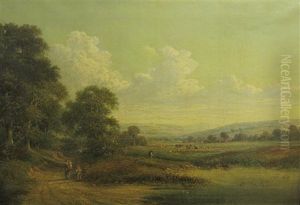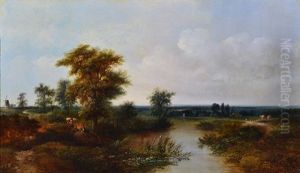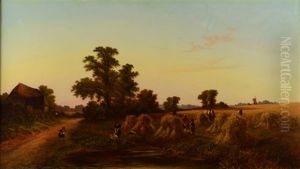Walter Heath Williams Paintings
Walter Heath Williams was a distinguished British landscape painter, born in 1835 in the picturesque surroundings of northern England. He was part of the Victorian era of artists who were deeply influenced by the Romantic movement, which emphasized emotion and individualism as well as glorification of the past and nature. Williams was particularly known for his ability to capture the serene beauty of the English and Welsh countryside within his works.
Williams's journey into the arts was fostered by his environment and possibly by an artistic family background, although specific details of his early life and training are not extensively documented. What is clear, however, is that his works began to gain public attention in the mid-19th century, a period that saw a burgeoning appreciation for landscape painting, driven by a societal yearning for an escape from the industrial revolution's urban sprawl and its associated environmental degradation.
Throughout his career, Walter Heath Williams exhibited a profound mastery over his medium, often employing oil paint to depict the lush, verdant landscapes that surrounded him. His works are characterized by a meticulous attention to detail, a vibrant palette, and an almost ethereal quality of light, which he used to highlight the natural beauty of rural scenes. His paintings often depicted quiet rivers, tranquil meadows, and rustic cottages, imbued with a sense of peace and timelessness.
Williams's contributions to the art world were recognized through his exhibitions at prestigious institutions. He exhibited at the Royal Academy, the British Institution, and the Royal Society of British Artists, among others. These exhibitions were critical in establishing his reputation and in ensuring his works were seen by a wider audience, including potential patrons.
Despite the recognition he received during his lifetime, Walter Heath Williams did not achieve the same lasting fame as some of his contemporaries. However, his paintings continue to be appreciated by collectors and art enthusiasts, particularly those with an affection for the Romantic landscape tradition. His works are held in various public and private collections, serving as a testament to his skill and his passionate portrayal of the natural world.
Williams passed away in 1906, leaving behind a legacy encapsulated in his serene and beautiful landscapes. His artwork remains a valuable window into the 19th-century British countryside, offering a glimpse into the rural beauty that was increasingly idealized during the era of industrialization. Through his paintings, Walter Heath Williams not only captured the aesthetic essence of his surroundings but also contributed to the broader Victorian cultural heritage, celebrating the natural landscape as a source of inspiration, solace, and beauty.

























